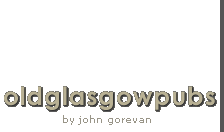News 2007.
News 2007...
17th December 2007.
Merry Christmas to you all.
Added this month is Duncan Walker, Wholesale Wine, Spirit and Beer Merchant, 233 Hope Street. His son was proprietor of the Cross Keys, Kirkintilloch. To read more Click here.
Also included this month is Christopher Foulkes, 1-2 Adelphi Street, Gorbals, Glasgow. Click here.
William Smith proprietor of the Vaults, and the Queen's Hotel, Dundee. Click here.
William Murdoch, University Restaurant, Sauchiehall Street, Glasgow. Click Here.
James Mearns, Oriental Bar, Gallowgate, Aberdeen. Click here.
Hugh Tennent, Wellpark Brewery. Click Here.
John MacDonald, president of the S.L.T Defence Association. Click here.
James Purves, S.S.C, Secretary of the Licensed Trade Defence Association. Click here.
Greenlees Brothers, Bonded Stores, Osbourne Street, Glasgow. Click here.
James McRobert, the Bucks Head, Hamilton Street, Greenock. Click here.
Councilor McQueen, Rothesay. Click here.
Robert Stoddart, manager of the Rob Roy Vaults, Argyle Street. Click here.
Alexander W MacLeod, Eglinton Street, Glasgow. Click here.
John White, Waterloo Street, Glasgow. Click here.
Andrew R McKenzie, wholesale and retail wine & spirit merchant, Stobcross, Street, Glasgow. Click here.
John McIntyre, Stobcross Street, Glasgow. Click here.
Hector Munro, 45 Cheapside Street, Glasgow. Click here.
Alexander Ross, Blythswood Street, Glasgow. Click here.
William Doherty, Victoria Hotel and Hall, Hamilton. Click here.
Allan Gilmour, Govan Street, Glasgow. Click here.
William Neilson, South Portland Street, Glasgow. Click here.
John Maitland, Station Hotel, Bridge Street, Glasgow. Click here.
George Buchanan, the Rob Roy Vaults, Argyle Street, Glasgow . Click here.
John McCall, Era Vaults, West Nile Street, Glasgow. Click here.
Hugh McPhee, Bernard Street, Bridgeton, Glasgow. Click here.
13th November 2007.
Over the years I have been asked if I know anything about the lost Memorial Plaque which used to be in the Garscube Bar.
This memorial plaque used to hang proudly displayed on one of the walls in the Garscube Bar known by the locals as Kiernan's, this old bar sat at the corner of Lyon Street, a rather small street with a lot of lost memories. It is said that more men died in this street than any other street in the UK, during the First World War.
At eleven o'clock in the morning on each November 11th bagpipes played "The Flowers O' the Forest", the kilted piper march from Maryhill Barracks. After a two minute silence a bugle played "The last post." After a long salute the two riflemen marched back to Maryhill Barracks. The Highland Light Infantry had honored its dead once more. This memorial went on for over 40 years.
At the corner of Garscube Road and Lyon Street a large black cross adorned with a wreath and poppies and beside it a Roll of Honour in a golden frame, brought out from the Garscube Bar for the day, after which the plaque was returned to the bar. When the pub was demolished along with Lyon Street the plaque is supposed to have went to St Joseph's Church in North Woodside Road. When the Church closed the plaque disappeared, it's a shame that this part of our social history is lost.
Do you known anything about this plaque or any of the soldiers names please get in touch.
More Entertainers are listed included are Mr J M Lonie a Tenor Vocalist, Mr J C Lawrence a Scotch Character, comedian and mimic, Miss Helen Duncanson a Soprano vocalist, and BABY Violet MacFarlane. Click here to read more.
The Victoria Bar, Market Square, Kilsyth, 1900, sorry no photographs of this pub.
The Clachan, 224 Buchanan Street, Glasgow 1900. sorry no photographs.
23rd October 2007.
100 years ago on October.
A Publican fined.
Frederick Lorkin, licence holder was at the Western Police Court, Glasgow, on Friday, charged with having in his premises at 68 Cranston Street, on 21st October, sold by the hands of his shopman, Frederick Lorkin jun. whisky to several girls whilst they were in a state of intoxication. He pleaded not guilty and was defended by Mr F MacQuisten. Mary Carrol, who is only 15 years of age, stated that she and another girl named Cissie McCracken went into a room in Lorkin’s public house about 9 on Sat night, 21st Sept. Witness ordered 2 glasses of whisky one for each, and after they had consumed the liquor they were joined by 2 other girls, one of whom called for a glass of whisky for each of the four. Having drunk it another round was ordered. Frederick Lorkin jun the son of the accused, who served them was going to refuse to supply it, but, having told them to be quiet he brought the four glasses in. They consumed this and then three glasses of whisky and a bottle of soda were ordered. The soda was for a girl called Kelly who was too drunk to take any more whisky. Witness was intoxicated when the 3rd round was ordered, and did not remember drinking her share. The girls afterwards left the pub and went into a fish supper shop. She remembered entering the shop but everything else was blank till she wakened in the Police office.
A pretty girl named Ann Jane McCracken known as Cissie 16 years of age, corroborated, she stated that she was drunk when the 3rd glass of whisky was ordered. Police evidence was afterwards given to the effect that carrol and McCracken were arrested in Argyle Street on Sat night 21st Oct for being helplessly drunk and that they pleaded guilty at the following Monday’s Police court to a charge of drunkenness.
Mr F L jun. stated that the girls were in the shop for half an hour, he served them two rounds only, refusing to bring any more owing to one of the girls using obscene language, they left the shop quite quietly. Mr F L sen, 75 years of age stated that he had held the licence since 1875, he had sold the business not to his son, but to another man subject to the transfer being granted on Tuesday. Bailie Dunlop found the charge proved and imposed a fine of £5 with the alternative of 30 days imprisonment.
A petty young terrier was the cause of the dispute.
On 26th Sept 1906, the dog was found in possession of an Italian in a shop at 100 Bardowie Street, Possilpark. As a result of information received by the police, and now claimed by Mr Archibald McKinnon, of Shawlands, and the Italian, Nicoli Pierotti. Mr McKinnon, a publican of Parliamentary Road, residing in Shawlands, said that he purchased the dog in October of last year from Mr Wilson, a dairyman, Parliamentary Road. It was an exceedingly valuable breed of dog, and he gave £2 and another animal for the terrier. After that Mr Wilson kept the dog for him in his stables as he had negotiations with a man in the United States. The dog appeared in November last, after which he instituted a thorough search, going to the dog and cat home three or four times. In consequence of what he learned recently, he went to the Italians fried fish and supper shop in Possilpark, where he found the dog. The Italian said the dog was his, and was very angry when they claimed the animal.
Cross examined by Mr Hart, witness said the dog was born in 9th April 1906. The Italian flourished the licence in their faces when they went into the shop, he did not know the dog was at the Falkirk show (He Witness) was a winner at that show, also show manager. Mr Hart handed witness a catalogue with the entry of the dog at the Falkirk show by the Italian under the name of TEDO with the words “term unknown” after long court session the dog was Mr McKinnon’s and that compensation at the rate of 3s 6d per week be paid the Italian from Nov 1906.
SEVEN YEARS FOR A GLASGOW HOUSEBREAKER.
Before Lord Justice Clerk in the High Court at Edinburgh on Monday there was brought up for sentence a middle aged man named William Mitchell on a charge of having on Feb. 5th in consent with George Green at present in Barlinnie, broken into Mathew Hendrie's Spirit Shop, 78 Wellington Street, Glasgow and stolen a cheque for £6. 4s shillings, and a key and secondly with maliciously destroying 8 bottles of brandy, 4 gallons of rum and a number of books, several drawers and a desk It was stated that the prisoner was watching outside and played a very minor part in the affair. The Lord Justice Clerk said it was impossible to deal with the prisoner as other than a criminal of confirmed character. A sentence of 7 years had been followed by 2 of 15 and 18 months respectively and the present offence was committed 2 days after his liberation from prison. In these circumstances his Lordship could only repeat the sentence of 7 years penal servitude.
50 Years ago on October.
Who named the H.LI
Fifty Years Ago in 1957.
One of the brightest and most attractive pieces of re-decoration seen for a long time had just been completed at the H.L.I Bar in Maryhill Road, Glasgow.
The name, in view of events, has been happily chosen, but it was selected long in advance of the present publicity for the affairs of the H.L.I.
The idea, in fact, came from a customer. He suggested the Happy Lads Inn, using the initials of the H.L.I. It was decided to use the letters and not the words, but the customer got the prize of a bottle of whisky for all that.
So now, with the prospect of an H.L.I. / R.S.F. merger, the public house had acquire something of an historic interest.
H.L.I. Decoration.
In a measure it has that already, of course, for the theme of its decoration was entirely H.L.I. and official blessing, as it were, was given to the project by the presence as a guest at the opening of Major B S M Carson, commander of the H.L.I. Depot at Maryhill Barracks.
Above the long gantry was a most handsome mural painting of men of the H.L.I. in the regiment’s various uniforms. The artist Mr Douglas Anderson, had specialised in military painting, and he at one time was adjutant of the H.L.I.’s 1st Battalion. He was still associated with the regiment as honorary curator of the H.L.I.’s regimental museum.
For the walls he had painted a series of studies of the regiment’s headdress from 1777 onwards. And to adorn the pubs facade he had carved and painted a striking effigy in wood of an H.L.I. braw laddie.
Mr Anderson’s mural had been given a coating of a special preparation which, when it dirties, may be removed and re-applied again without harming the painting or affecting its colouring in any way.
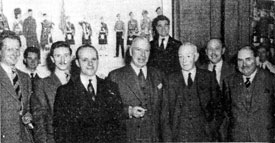
Seen in the photograph above left to right is Captain A. G. Ingram, adjutant, H.L.I.; Mr D Anderson artist; Mr N Andrew, licence holder; Colonel Robert Younger, chairman, Robert Younger, Ltd.; Mr J B Millar managing director, Robert Younger’s; Major B. S. M. Carson, Commander, Maryhill Depot, H.L.I.; and Mr D Ross, director, Robert Younger’s. In the background is Mr J Webster, charge-hand.
Entertainment.
On the subject of entertainment in Glasgow Pubs I send my condolences to the family of Frank Feeney, a well known and respected Glasgow entertainer and an old friend of myself. Frank was probably better known as Frank Hassen, (his stage name) who played the keyboards in hundreds of pubs and clubs in and around central Scotland. Frank was a fantastic talented musician, accompanied with his daughters Elaine and Ann.
Many will remember Frank in Betty's Bar, Gallowgate, the Riverside Tavern, Gorbals the Rangers Club, Ibrox, the list goes on and on, he was one of the first entertainers in the Swinging Doors night club in Parkhead in the 1980s. His whole life was dedicated to entertaining, he was well known to leave a night club in the early hours and begin a music rehearsal for his next gig on the same night.
R.I.P. Frank Hassen.
Glasgow pubs have always been well known for the fact that you can get a laugh a singalong and get entertained by the many different groups and entertainers. The Horseshoe Bar, Drury Street, the old Ship bank, Saltmarket and the old College on High Street have a wonderful singing talent and of them have made it to the top of the pops. Glasgow in 1900 had its fare share of talent too, like Pete and Miss Minnie Lee.
Black and White Specialty Artistes, Vocalists and Instrumentalists.
41 Eveline Street, Dennistoun, Glasgow.
Mr Pete Williamson, who takes the stage name of Lee, was a native of Yoker, but has received most of his education in Glasgow. It was at one time intended that he should enter the Church and become a minister, but found himself as a lad apprenticed to a firm of glass painters and embossers. Having a strong musical bias he always found time to devote himself to its study, and in this capacity was one of the originators of the popular Georgian Minstrels somewhere about 1890, in which combination he was also principal comedian and top-boot dancer. For this latter accomplishment he won a gold medal in a competition at Beith in 1893. A little over three years ago he left the minstrels troupe and decided on courting the verdict of public opinion as a solo performer, but meeting with Miss Lee they agreed to collaborate as duettists and musical and variety sketch artistes, with what conspicuous success is well known to the patrons of our concerts.
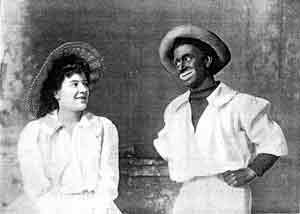
Mr Pete & Miss Minnie Lee. circa 1900.
Miss Minnie Lee was also born in Glasgow. After receiving a good and thorough education, including a lengthened course of music, with the intention of becoming a teacher of that art, her mother died, and with that resourcefulness which is characteristic of the lady, at once decided to discontinue her studies and joined the Theatre Royal Stock Company. For a time she also travelled with “For the Crown” company, and after having gained considerable experience, which her apt and receptive nature enabled her to pick up quickly started for herself as a coon singer, serio, mandolinist, and dancer. Her early training has qualified her admirably for a concert pianist, in which, as well as in the manipulation of many other instruments, her execution and proficiency are above the average.
As duettists they are equally at home with either banjo, mandolin, guitar, sleigh bells, musical glasses, etc., including the xylophone, which has been lately introduced into their entertainments. Since their appearance before the public they have met with phenomenal success. They give their annual concert in the Albert Halls in College Street on the 18th of February, at which many well known to both the public and the professional assisted.
Other entertainers click here.
16th October 2007.
Thanks to Jimmy Gibbons ex Daily Record and Sunday Mail employee, for his email... I frequented "The Monty" (Montrose Bar) in various roles since the early fifties. My uncle Peter Kelly was a Stoker on the boats on the Broomielaw, working 24 hour shifts stoking the furnaces.
Wee John Cassidy (a gentleman and his partner George) opened the pub on Sundays to sell me 2 bottles of whisky for Big Peter, because he really worked up a thirst in the heat of the engine room.
A few years later, being employed at the Daily Record and Sunday Mail I became a Regular in the MONTY. I may bring your files on licence holders up to date., when John Cassidy retired his nephew Tony Taylor (ex Celtic footballer) took over the licence. Then there was Larry Diamond brother of Jim Diamond.. Pop Star... After them it was the twins... Scott and Jim Savage and finally it was Big Jim Cullen... Mine host until the MONTY closed.
I have lots of fond memories of this establishment... I still meet Jim Cullen and my ex colleagues of the Press.
Jimmy Gibbons.
29th September 2007.
Caly Road pubs (Caledonia Road)
26th September 2007.
The Mail Box has been identified, the pub was at 466 Paisley Road now known as the Quay, what a transformation. Thanks to everyone who recognised this pub.

The Mail Box. 1980s.
RG's now with all the Mod Con's.
RG's has turned the clocks back to the 1960s with a name change the Twisted Wheel named after mod club of the 1960s, the pub with its basement club has a licence until 1am with a 3am licence on the cards. The new club promises to have Fridays DJ and free live bands while Saturday is focused on growing talented DJs. Despite the new look and music theme the bar's fab style art deco remains unchanged.
Forgotten Pubs
One of the main projects of this website is to name as many of the old pubs in the city of Glasgow as possible, thanks to the numerous readers with your pub names especially Old Bob who has named twenty forgotten pubs, Cheers mate.
The Gorbals
The Gorbals has been a popular subject lately or should I say Gorbals Pubs. In the early part of the 1900s Caledonia Road had 14 pubs to its name, by the 1960s there were only a hand full left, can you remember any of them. If so please get in touch.
Crown Street had 20 pubs, Cumberland had 16 as did Eglinton Street, Ballater Street formerly Govan Street had 14 pubs, Hospital Street had 9, Main Street or Gorbals Street had 15, Norfolk Street had 10, Nelson Street had 8, Rutherglen Road had a massive 26 public houses and 3 off Licensed premises and even more shebeens.
Victorian Glasgow was booming so were the pubs at that time, Glasgow had 1400 pubs 309 Off Licensed premises 19 hotels. This was an enormous amount especially when the city had a population of less than 750,000 people. The Gorbals was split into 4 different wards Hutchesontown had 57 pubs, the Gorbals ward had 95, Kingston had 103 pubs and Govanhill had 13.
The Horn Bar.
One well known pub in the Gorbals was the Horn Bar which sat on 62 Thistle Street, this old pub dated from 1870s. The landlord was then Robert Robin a well known publican who had other pubs in the city including Charlotte Street, Sydney Court off Argyle Street, Elderslie Street and Anderson Quay, his son also named Robert had pubs in Rutherglen Loan and Great Hamilton Street now London Road. The Horn bar was opened in 1894 by a gentleman called John Nicholson who formerly managed the premises and took charge of the proprietors other pub in Govan before taking over the Thistle Street premises. The pub was totally gutted a new family department was added to the pub which was entered from a separate door, this proved to be a very lucrative business indeed. A new 36 foot mahogany bar counter was installed with a handsome spirit rack and gantry with all the mod cons. The little snug's were cosily furnished and fitted with electric bells the whole establishment was very bright with the use of the very large stained glass windows, panels and mirrors. All the best liquor was stocked at the Horn bar included was the "Horn Club" blend of Scotch Whisky. From its proximity to the Royal Princess Theatre, numerous well known professionals were among Mr Nicholson customers, theatrical newspapers were always at hand.
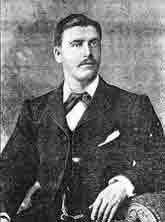
Mr John Nicholson. 1895.
In 1907 a new landlord took over the pub, Mr William Keith took charge and continued until the end of the First World War. One of the last licensee to run the pub was John Cumming, many will still remember him, the pub closed its doors for the last time in the 1960s when most of the old pubs were demolished. Do you remember this pub? maybe you remember this pub with a different name, if so please get in touch.
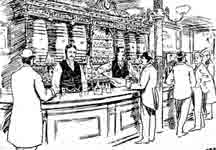
Interior view of the Horn Bar. 1895.
International footballer fae the Gorbals.
Jimmy Howieson was a sportsman an International footballer, who had been in the licensed trade all his life. Many of his fans thought that Jimmy Howieson entered the trade after his playing days were over.
James Howieson was born in 1900 in the Gorbals and had three sisters and two brothers all of whom had worked in their father’s pub in Queen Street especially during the summer holidays.
James followed in his father’s footsteps an owned the Railway Tavern at 520 Rutherglen Road not far from his place of birth, his father John owned the Crammond Bar, 157 Queen Street for thirty five years a licence which was taken over by Mrs Howieson when her husband died.
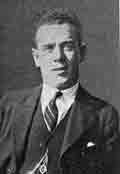
Jimmy Howieson.
Jimmy was educated at Rutherglen Elementary School and John Street School. Strange to say, he was not one of those boy football fanatics who had carved themselves a niche in the hall of soccer fame.
After school, James worked with his father in the pub before embarking on a career as a marine engineer. That was when he started out to be, and he served two years of his time before an accident and a few smashed fingers led his feet, very literally, in another direction.
This happened near the end of 1917 and the day he was discharged from hospital found him making tracks for the nearest Navy recruiting office. He signed on to serve twenty five years with the Senior Service. In his youth, like other lads of his age, he used to kick a ball up and down Rutherglen Road and in the parks, but he never played football in a recognised team, school or otherwise, until he joined the Navy. In fact, he had little time to play, because when he was at home he was either at work or giving his father a hand in the Crammond Bar.
By the way, the Crammond Bar was named after his fathers favourite place near Edinburgh the Crammond Village.
In the Navy, playing football for the ship’s team, he played against all nationalities, and in all climates. Matches were played at Cape Town, the West Indies, Spain and whatever port of call they weighed anchor. The football of those days was on the he-man variety, and made Jimmy as tough as they make them.
Came 1921, and while he was on shore leave he received permission from the skipper to play football at home. He played a few games for junior combines, Port Glasgow being his first team, and he played along with a companion from the ship called Duffy, who was an all round athlete.
Of the two, Howieson was the one who found the game most attractive, and with a sum close on £50 he bought his discharge from the Navy and settled down to be a footballer.
He played for Rutherglen Glencairn until the end of the season and then signed for Airdrieonians. In the following year the Lanarkshire team won the Scottish Cup and Jimmy secured his first cup medal. At the end of that season he joined the ranks of St Johnstone at Muirton Park, Perth and then began a series of exchanges which amazed the football world.
He played for St. Johnstone in their League games and for St. Mirren in their cup ties: All this in the same season and it was affected by transferring him backwards and forwards as if he were a shuttle-cock. That is something that cannot happen today, with the S. F. A.’s rulings on the subject, but it gave Jimmy Howieson both traveling and experience of the world.
At the end of the season, instead of going to St. Mirren as everyone had thought would have happened, he signed up for Dundee United, but his career with them was a short one and mid-way through the next season he was on the Paisley eleven’s books. Fate must have prompted that signing, for by the last day of the 1926-27 fixture list, Jimmy had secured a second Scottish Cup Medal.
St. Mirren for the first time in their career won the cup, beating Celtic in a memorable final 2-0, and it was Jimmy Howieson who clinched matters with a second goal. The same year he received his cap against Ireland and at the end of the season Hull City tabled £3200 for his transfer. St. Mirren accepted, and Howieson went through to England for his first taste of football over the Scottish borders.
He just couldn't’t settle there, however, and was badly off form, and eventually turned down the retaining fee offer that made him and packed his grip for the United States of American.
He played for New Bedford and New York Giants and found himself back in the old Navy style of game. The money was good, however, despite the fact that the gate was small. The prices charged for admission in those days were something like a dollar and a quarter (five shillings or more).
A cable from Hull City offering new terms brought him back to British soil and he joined their forward line once more. That year Hull City went to the semi-final of the English Cup and Jimmy almost had an English Cup medal to add to his Scottish pair. Hull City was leading 2-0 with about fifteen minutes to go, when, after a change in their formation, Arsenal drew level. They won the re-play and went on to win the cup.
That match, says Jimmy, was by far the most exciting of his whole career, beating the Celtic-St. Mirren final easily for the position.
Placed on Hull City’s open to transfer list at the same price at which they paid for him £3200, Jimmy went to Ireland and played there for two years with Shelbourne and they won the Free State League and the Leicester Shield while he associated with them. When he left Irish football he joined Clyde, a football team which he had supported as a youth, and for whom he still had a soft spot for until he died. Two years service with them and back to Ireland again. This time he hung his boots in the Glenavon locker and then shifted them to Belfast Celtic’s pavilion, just a month before his brother and himself took over the Railway Tavern. For several years Jimmy had been on the look-out for such a pub and when the opportunity came he took it. And so many fans frequented his new pub in the hope of getting an autograph and a chat about his football career.
Do you remember Jimmy’s pub the Railway Tavern or one of his father’s pubs? If so please get in touch. One of the last licensee for the Railway Tavern was a lady called Margaret Bogle.
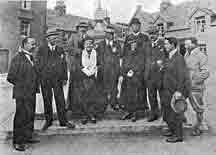
Gorbals Local Veto Defence Association. 1924.
This interesting photograph taken on a day trip to Largs, with the Gorbals Local Veto Defence Association. The Gorbals Local Veto Defence Association was set up to voice the local publicans who's businesses would have perished long before the 1950s and 60s City Councils clearance. The temperance movement was at full swing which saw many publicans out of business losing their lively-hood. The whole of Pollokshaws ward went dry in 1920 as a result of the temperance movement. Thanks to these guy the Gorbals was saved and very few of the pub were closed during the height of the clearances.
In the photograph above is Mr & Mrs John Holmes who had premises in Bedford Street, Mr & Mrs William Keith who had pubs on Thistle Street and Gorbals Street, Mr Francis McAvoy, he had pubs on the Gallowgate and Scotland Street, Mr Patrick McKernan, he had a pub on Cumberland Street, Mr John Gallagher, who had a pub on Adelphi Street, Mr James Cleland, Hospital Street Mr William McDonald, assistant organiser, he had a pub on Cumberland Street and Mr William McLeod, Treasurer, who had a pub on Eglinton Street.
Bonfire made from Gorbals Pub.
On V.J. night a celebrating crowd broke into Thomas McGinn’s pub at number 251 Rutherglen Road, Gorbals, and made a victory bonfire. The frenzied crowd tore up the floor boards, the shelves and the gantries, stripped the walls the seats everything to make a bonfire on Rutherglen Road, even the large barrel of McGinn's special blend of old Scotch whisky "Ye Olde Judge" was set ablaze.
But Mr McGinn celebrated his own victory with the opening of a magnificent new road house situated just off Paisley Road West in Broomloan Road. A short distance down the Broomloan Road was Ibrox Stadium home of Rangers F.C. Appropriately Mr McGinn named his new premises Ibrox House.
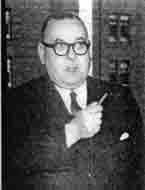
Mr Thomas McGinn.
He could scarcely have chosen a more ideal spot. In addition to the football stadium there was also the Albion and White City greyhound racing tracks close by as well as Ibrox Station. Mr McGinn was invalided out of the R.A.F. two or three weeks before the celebrating crowd destroyed his Rutherglen Road premises. For the next 12 months he was in Hospital and for six months he was convalescent. He was unable to restore his premises because it was not then possible to obtain a timber permit. Then came the next blow. His premises were compulsorily acquired by the City Council for demolition to make way for the new improvements to the Gorbals. Although he also held the licence for premises at 246 Paisley Road Mr McGinn began to look around for premises to replace the Rutherglen Road pub. His idea was to have large new premises that would be a credit to the city. At the corner of Broomloan Road and Paisley Road West he found the idea site. His application to the Licensing Court proved successful, but he had to surrender the Paisley Road licence.
Mr McGinn was assisted in his premises by his two sons and daughter, Paul manager, Thomas jun and Patricia (Mrs R G Watt.) And traded under the title of Thomas McGinn & Sons. Ibrox House had its motto: Semper Idem (Always the Same.) On the crest was a crown the road house was built on crown property. In the centre was the letters I.B., which stood for Ib Broch, which means the home of the badger. Underneath between the works Semper and Idem was a badger’s head.
On the ground floor of the premises was a spacious well appointed public bar, the bar itself extended the full length of the room. It was estimated that 1800 pints can be served in an hour. There was plenty of comfortable seating accommodation. Upstairs was a bright lounge bar and restaurant with seating accommodation for 120 people. Ample car parking space was also provided.
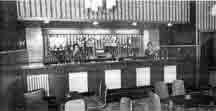
Interior of Ibrox House. 1958.
Mr McGinn himself declared the premises open in 1958 when he invited a large company of Trade personalities, in which wholesale houses were well represented and friends to the opening ceremony. Among those at the top table were Mr Balfour, director of William McEwan & Co Ltd., Mr MacDonald manager of McEwan’s and Mr A Don manager of G & C Moore Ltd. Mr Balfour’; speaking after the luncheon, said that the Ibrox House marked the fulfillment of a dream the McGinn’s have had for many years. That day the dream had become a reality. They had to congratulate Mr McGinn on three points. The site chosen could not have been a better one; the building represented the idea of what a public house should be. The business was a family concern. Mr Balfour then proposed a toast to Ibrox House and to the McGinn family.

This interesting Gorbals photograph of the Citizen's Bar darts team taken in 1972. The Citizen's Bar had a record breaking fourth time winner of the Guinness Darts shield, beating the Ceilidh Bar, Clyde Street in the final. Pictured below are Mr C Sweeney, proprietor of the Citizen's Bar, W Martin, captain, Bob Connolly area representative, Guinness who presented the trophies in the Citizen's Bar, G McGinlay, Ceilidh captain and J A Bailie assistant regional manager, Guinness. Do you remember any of the guys here?
4th September 2007.
First of all I would like to apologies for the time it has taken for an update.
After a long spell in hospital I am now in the position to update the website on a regular basis.
The Hielan Jessie has ordered more booklets on the popular "Up & Doon the Gallowgate." It's nice to see so many people enjoying this read, it will bring back a lot of memories to folk in the East End of the city.
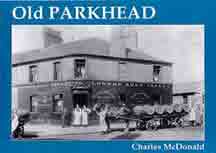
Thanks to Norrie Mcnamee and Peter Mortimer for their emails, they are members of a newly setup message board www.http://glesgakeelie.proboards.com/ the mastermind of author and local historian Charlie McDonald.
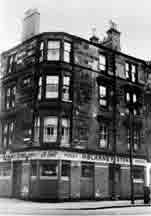
Norrie Mcnamee sent in this photograph of the Blarney Stone, Caledonia Road, Gorbals on the south side of the city. After Norrie had a swatch on my website he recall's going into the Hawthorn Bar where he had his first pint of Guinness in 1963 costing him a wacking 2/6d, he also went on to say that the Hawthorn Bar moved to the site of the Avon Cinema on Saracen Street in between Closeburn Street and Saracen Cross. The pub soon went on to earn the name of the Stab Inn. One day some local neds walked into the pub and calmly stole the TV.
Directors Box found...
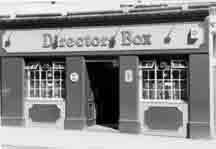
Many Thanks to Norrie Mcnamee he also ID one of the forgotten pubs "the Director's Box" which sat on Hope Street just around the corner of Renfrew Street Post Office right across from the Savoy Cinema (later the Majestic Ballroom,) right had side of Hope Street between Renfrew Street and Sauchiehall Street.
Peter Mortimer recall's "Chathams at 424 Ballater Street was previously known as the St. Mungo Bar, (my father drank in there,) it has now been demolished, and like so many old pubs, the site is now occupied by flats."
"The Langfield 256 Cambuslang Road now demolished, site of flats now. The Lea Rig, Alexandra Parade occupied the former grocery store of A. Cochrane & Co.. McLaren's, 1046 Gallowgate was known as in its latter days as the Mill Inn. The Mission, 160 Battlefield Road, site of the Queens Cinema, built in 1922 to seat 550, also known as The Tonic."
11th May 2007.
The opening of Sloan's, Argyll Arcade.
Last night I was invited once again to the opening of Sloan's at Argyll Arcade. I was dropped off on Argyle Street face the lane that takes you to Morrison Court. My first vision was the crowd outside, some of them standing and a few sitting at the table and chairs, It was quite cold to be sitting out last night however those who were outside were smoking and meeting their partners or friends. The graffiti was still a problem I noticed on the fall facing the entrance. The refurbishment from the outside was not to my taste, the paneled wood looked rather cheap and nasty the owners Billy McAneney and Oli Norman of DaDa could have stripped the old paint off the walls and displayed the original stonework.
On entry I noticed the large gathering of people at the main bar and surrounding area, all the booths were full of customers. A new floor was replaced by a Laminate wood flooring formerly white tiles with small black inlay's. Large photographs of Old Glasgow scenes adorned the walls.
I then met my brother Kev who directed me to the wine and cider tasting, Kev obviously liked the wine and I opt for the cider which was very nice and sweet. I then gave my brother a detailed tour of the building by then poor Kev was very thirsty, the kind Rep filled his glass once more.
I noticed the ceiling and cornice had been re painted, the gold was a bit yellow and to bright. We were presented with a tray of canape's, very nice, very tasty and well displayed.
In all Sloan's is a magic Glasgow hidden treasure well worth the visit, I hope the new owners will keep the doors open a little longer than the last owners, Sloan's is now a national treasure and a Glasgow Institution. The newspapers state that £2million revival and restoration at the oldest restaurant in the city, it is true that Sloan's is the oldest restaurant in Glasgow however I could not see how £2million quid was spent on refurbishment, I could have done it for half of that....
End.
